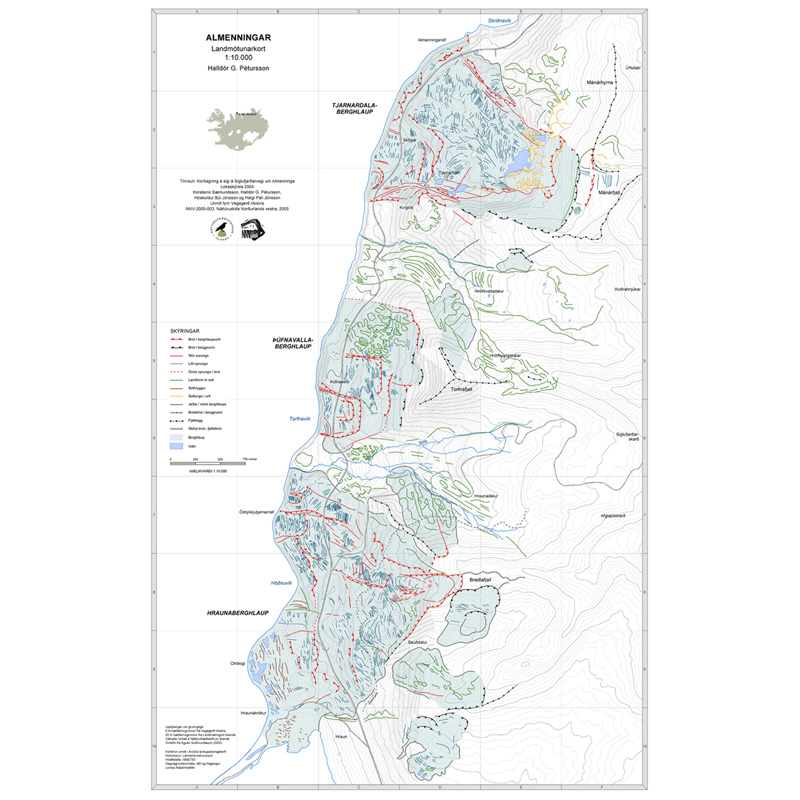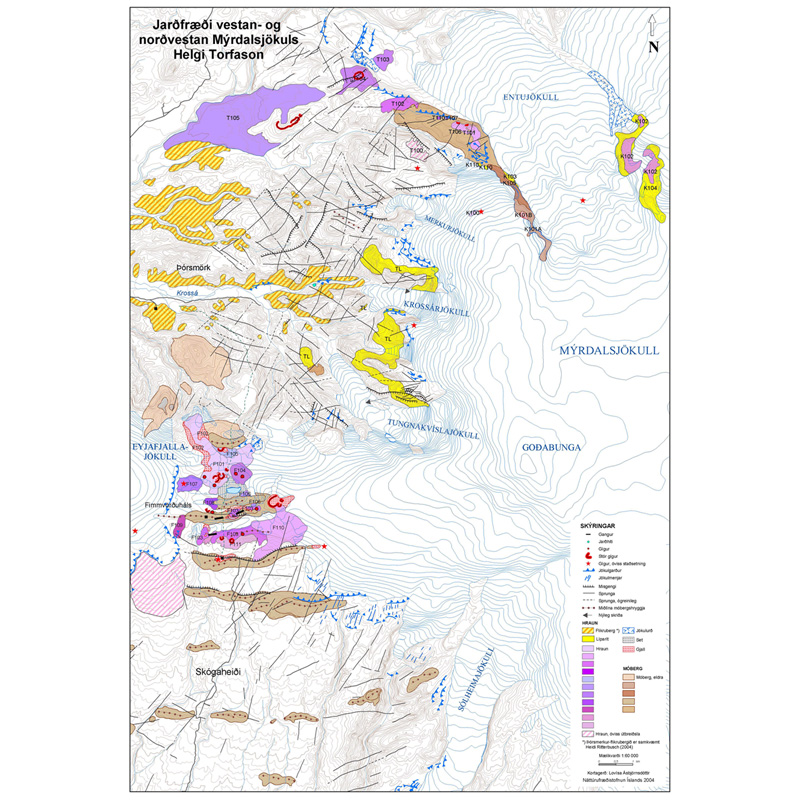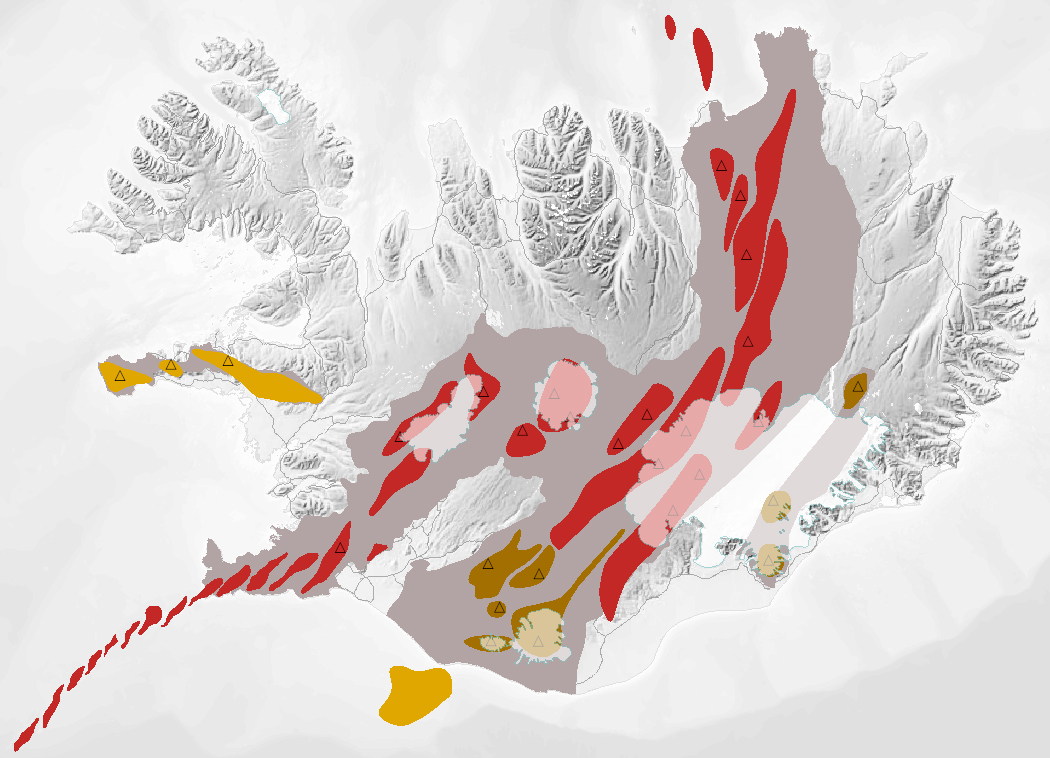Natural risk zones
Type of resources
Available actions
Topics
Keywords
Contact for the resource
Provided by
Years
Formats
Service types
Scale
Resolution
-

Gagnasafn (GDB) NI_J10v_AlmenningarLandmotun: Almenningar - Landmótunarkort – 1:10.000 [Almenningar – Geomorphological map – 1:10.000]. Rannsóknir á sighreyfingum á vegstæði Siglufjarðarvegar um Almenninga. Á svæðinu var kortlagt yfirborð og jarðlagaskipan lausra jarðlaga og berggrunnur kannaður. Bornar voru saman mæliniðurstöður Vegagerðarinnar á sighraða á vegstæðinu, veðurfarsgögn og ritaðar heimildir um sighreyfingar til að kanna orsakatengsl. Unnið fyrir Vegagerð ríkisins í samstarfi við Náttúrustofu Norðurlands vestra.
-

Gagnasafn (GDB) NI_J60v_MyrdalsjökullNV: Jarðfræði vestan og norðvestan Mýrdalsjökuls – 1:60.000 [Geology west and northwest of Myrdalsjokull – 1:60.000]. Kortið sýnir jarðfræði svæðisins frá Fimmvörðuhálsi norður í Entujökul. Kortlögð voru brot, gígar og hraun, ummerki eftir skriður og framhlaup, jökulgarðar og jökulmenjar. Kortið var unnið í tengslum við útgáfu Ríkislögreglustjóra 2005 "Hættumat vegna eldgosa og hlaupa frá vestanverðum Mýrdalsjökli og Eyjafjallajökli".
-

Gagnasafn (GDB) NI_J600v_bergradir_ISN93_1.utg: NI_J600v Bergraðir Íslands – 1:600.000 [NI_J600v Igneous rock series of Iceland – 1:600.000]. Kort af þremur bergröðum Íslands. Kortið sýnir virk gosbelti á Íslandi og landgrunni þess á nútíma og síðjökultíma, virk eldstöðvakerfi á nútíma, útbreiðslu gosstöðva og samsetningu gosbergs (flákalag). Staðsetning megineldstöðva er einnig sýnd (punktalag). Gerður er greinarmunur á þóleiískum, alkalískum og millibergskerfum. [The map of the three igneous rock series of Iceland at a scale of 1:600.000 shows the volcanic zones active in Iceland and its insular shelf during the Holocene and Late Pleistocene, volcanic systems active during the Holocene, the distribution of eruption sites and chemical composition of erupted rocks (polygon layer). The position of central volcanoes is also shown (point layer). Tholeiitic, alkalic and transitional alkalic volcanic systems are differentiated.]
-
The European Ground Motion Service (EGMS) is a component of the Copernicus Land Monitoring Service. EGMS provides consistent, regular, standardised, harmonised and reliable information regarding natural and anthropogenic ground motion phenomena over the Copernicus Participating States and across national borders, with millimetre accuracy. This layer is produced based on GNSS data from various sources, with the EUREF Densification network as the main entry point. After filtering and quality control, a total of 3770 stations are used to generate the GNSS model which contains average velocities in east, north and up directions displayed on a 50-km grid. The grid dimension is determined by the average distance between well-maintained GNSS stations over continental Europe. The GNSS model is distributed to users in a single comma-separated values file. Each cell of the model is associated to a value of vertical and horizontal velocity. The product covers the Copernicus Participating States (except for DROMs) and United Kingdom.
-

The European Ground Motion Service (EGMS) is a component of the Copernicus Land Monitoring Service. EGMS provides consistent, regular, standardised, harmonised and reliable information regarding natural and anthropogenic ground motion phenomena over the Copernicus Participating States and across national borders, with millimetre accuracy. This layer is produced based on GNSS data from various sources, with the EUREF Densification network as the main entry point. After filtering and quality control, a total of 3770 stations are used to generate the GNSS model which contains average velocities in east, north and up directions displayed on a 50-km grid. The grid dimension is determined by the average distance between well-maintained GNSS stations over continental Europe. The GNSS model is distributed to users in a single comma-separated values file. Each cell of the model is associated to a value of vertical and horizontal velocity. The product covers the Copernicus Participating States (except for DROMs) and United Kingdom.
-

The European Ground Motion Service (EGMS) is a component of the Copernicus Land Monitoring Service. EGMS provides consistent, regular, standardised, harmonised and reliable information regarding natural and anthropogenic ground motion phenomena over the Copernicus Participating States and across national borders, with millimetre accuracy. This set of metadata describes the third product level of EGMS: Ortho. to derive two further layers; one of purely vertical displacements (the one described by this metadata), the other of purely east-west displacements. Both layers are resampled to a 100 m grid. The Ortho product eases the interpretation process of non-experts since the viewing geometry has not to be considered anymore. EGMS Ortho is visualised as a vector map of measurement points colour-coded by average velocity (vertical or east-west components) and distributed to users in comma-separated values format. Each point is associated with a time series of displacement, i.e. a plot with values of displacement per acquisition of the satellite.
-

The European Ground Motion Service (EGMS) is a component of the Copernicus Land Monitoring Service. EGMS provides consistent, regular, standardised, harmonised and reliable information regarding natural and anthropogenic ground motion phenomena over the Copernicus Participating States and across national borders, with millimetre accuracy. This set of metadata describes the first product level of EGMS: Basic. The EGMS Basic - provides InSAR displacement data provided in the satellite Line-of-Sight (LOS), with annotated geo-localisation and quality measures per measurement point. This product is generated from the interferometric analysis of Sentinel-1 radar images at full resolution. It contains line of sight velocity maps in ascending and descending orbits with annotated geolocalisation and quality parameters per measurement point. The Basic product is referred to a local reference point; therefore, ground motion measurements are meaningful only within a small subset of the full product. It is not possible to compare deformation from adjacent areas belonging to different processing units of the same level. EGMS Basic is visualised as a vector map of measurement points colour-coded by average line-of-sight velocity and distributed to users in comma-separated values format. Each point is associated with a time series of displacement, i.e. a plot with values of displacement per acquisition of the satellite. The product is generated for both ascending and descending orbits. The processing of the dataset has taken place in the period from March 2024 to October 2024.
-

The European Ground Motion Service (EGMS), part of the Copernicus Land Monitoring Service, provides consistent, regular, standardised, harmonised, and reliable information on natural and anthropogenic ground motion phenomena across Copernicus Participating States and national borders, with millimetre-level accuracy. This metadata describes EGMS Ortho, the third product level in the EGMS portfolio. EGMS Ortho is derived from EGMS Calibrated through a resampling procedure onto a 100 m grid, using data from both ascending and descending satellite orbits. This process generates two distinct layers: one representing purely vertical displacements and one representing purely east-west displacements (the subject of this metadata). EGMS Ortho simplifies interpretation for non-expert users by removing the need to account for satellite viewing geometry, offering a more intuitive representation of ground motion. EGMS Ortho is visualised as a vector map of measurement points colour-coded by average velocity (vertical or east-west components) and distributed to users in comma-separated values format. Each point is associated with a time series of displacement, i.e. a plot with values of displacement per acquisition of the satellite.
-

The European Ground Motion Service (EGMS) is a component of the Copernicus Land Monitoring Service. EGMS provides consistent, regular, standardised, harmonised and reliable information regarding natural and anthropogenic ground motion phenomena over the Copernicus Participating States and across national borders, with millimetre accuracy. This set of metadata describes the second product level of EGMS: Calibrated. This product is considered the main EGMS product as it serves the needs of most users. but the measurement points are referenced to a model derived from global navigation satellite system data. Thus, the measurements are not relative anymore and are considered as absolute. The calibrated product makes it possible to compare ground motion measurements from adjacent areas belonging to different products of the same level. EGMS Calibrated is visualised as a vector map of measurement points, colour-coded by average velocity, and distributed to users in comma-separated values format. Each point is associated with a time series of displacement, i.e. a plot with values of displacement per acquisition of the satellite. The product is generated for both ascending and descending orbits.
-

The European Ground Motion Service (EGMS) is a component of the Copernicus Land Monitoring Service. EGMS provides consistent, regular, standardised, harmonised and reliable information regarding natural and anthropogenic ground motion phenomena over the Copernicus Participating States and across national borders, with millimetre accuracy. This set of metadata describes the third product level of EGMS: Ortho. to derive two further layers; one of purely vertical displacements, the other of purely east-west displacements (the one described by this metadata). Both layers are resampled to a 100 m grid. The Ortho product eases the interpretation process of non-experts since the viewing geometry has not to be considered anymore. EGMS Ortho is visualised as a vector map of measurement points colour-coded by average velocity (vertical or east-west components) and distributed to users in comma-separated values format. Each point is associated with a time series of displacement, i.e. a plot with values of displacement per acquisition of the satellite. The product covers the Copernicus Participating States and United Kingdom.
 Arctic SDI catalogue
Arctic SDI catalogue